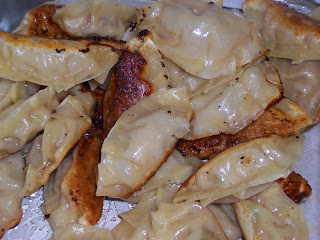Gyoza is something that I always loved to order when getting Japanese take-out but it was never a dish that I ever thought about making from scratch until a couple of years ago. I researched different techniques and changed ingredients to suit my taste. They make great appetizers hot or even cold, I love eating them cold as a snack. I always keep bags of them in my freezer for a quick meal option. Here is my recipe.
Ingredients:
1lb ground pork
1/2 cup finely chopped cabbage
1 medium sized yellow onion (chopped and then put in the blender)
4 cloves of garlic, minced
3 tablespoons soy sauce
1 1/2 tablespoons rice vinegar
1 teaspoon sesame oil
1/4 teaspoon ground ginger
1/4 teaspoon black pepper
2 packages of gyoza skins, thawed
Gyoza Filling and Preparation:
1. Combine all filling ingredients in a large bowl, cover and refrigerate for 30 minutes to an hour.
2. With a gyoza skin in the palm of your hand place a small spoonful of the filling in the center of the wrapper.
3. Dip a finger in water and trace the edge of the gyoza skin so that its a semi circle.
Fold one side over the other, fold the edges over the others pinching them together to seal the filling (an easier way is to use a gyoza press or to seal the edges with a fork like you would for a pie).
4. Add enough oil to coat the bottom of the pan, about 2 tbsp wait for the oil to heat up, then place the gyoza's in a nonstick pan at med-high heat, DO NOT MOVE THEM WHILE THEY ARE COOKING (keep them apart or they will stick together) cook them for 1 minute.
5. Then add about 1/2 cup water to the pan, cover and cook for about 6 minutes or until water has evaporated.
6. Remove lid and let cook for another 1-2 minutes depending on how brown you like them.
Place on paper towels to drain, serve hot with sweet chili sauce and hot white rice.
Freezing*
To freeze them, line a baking sheet with wax paper or parchment paper lay uncooked gyoza on the sheet but not touching each other. Freeze for about 45 minutes then put them in freezer bags and they are good for up to 3 months. When you feel like eating some just put them in a pan with enough oil to coat the bottom cook for about 2-3 minutes until they are golden brown on the bottom then add enough water to come 1/3 of the way up the gyoza then put a lid on them for 7 minutes then remove lid and let crisp up for another minute to 3 minutes.


? do you need to cook the pork first?
ReplyDeleteNo, it cooks through when you steam/sautee it
ReplyDelete